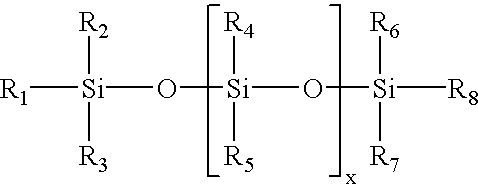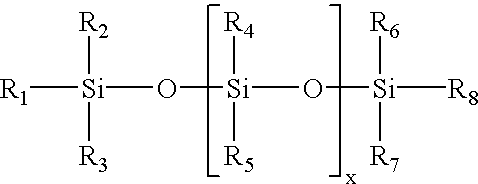Copolymerization of reactive silicone and urethane precursors for use in conductive, soft urethane rollers
a technology of reactive silicone and reactive urethane, which is applied in the direction of portable power-driven tools, instruments, and discharge of corona, can solve the problems of high cost, low production, and difficulty in coating a charge roller of high conductivity and soft durometer with one layer of rubber/foam (specifically urethane), and achieves low tackiness. the effect of good resistance to chang
- Summary
- Abstract
- Description
- Claims
- Application Information
AI Technical Summary
Benefits of technology
Problems solved by technology
Method used
Image
Examples
example 2-8
Charge rollers described in the following examples were prepared using the same general procedure used in Example 1. The following tables provide the amount (in parts) of each ingredient in the thermoset copolymer:
Listed below is the composition of conductive curative (stream A) in each of Examples 2-8:
Listed below is the composition of reactive silicone / polyol (stream B2) in each of Examples 2-8:
Physical properties of the roller prepared in each of Examples 2-8 are provided below:
examples 9-14
Developer rollers described in the following examples were prepared using the same general procedure used in Example 1. The following tables provide the amount (in parts) of each ingredient in the thermoset copolymer:
Listed below is the composition of conductive curative (stream A) in each of Examples 9-14:
Listed below is the composition of reactive silicone / polyol (stream B2) in each of Examples 9-14:
Properties of the roller prepared in each of Examples 9-14 are provided below:
PUM
| Property | Measurement | Unit |
|---|---|---|
| temperature | aaaaa | aaaaa |
| humidity | aaaaa | aaaaa |
| temperature | aaaaa | aaaaa |
Abstract
Description
Claims
Application Information
 Login to View More
Login to View More - R&D
- Intellectual Property
- Life Sciences
- Materials
- Tech Scout
- Unparalleled Data Quality
- Higher Quality Content
- 60% Fewer Hallucinations
Browse by: Latest US Patents, China's latest patents, Technical Efficacy Thesaurus, Application Domain, Technology Topic, Popular Technical Reports.
© 2025 PatSnap. All rights reserved.Legal|Privacy policy|Modern Slavery Act Transparency Statement|Sitemap|About US| Contact US: help@patsnap.com



